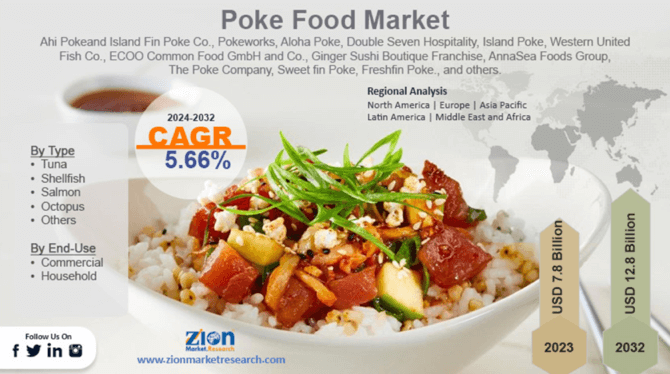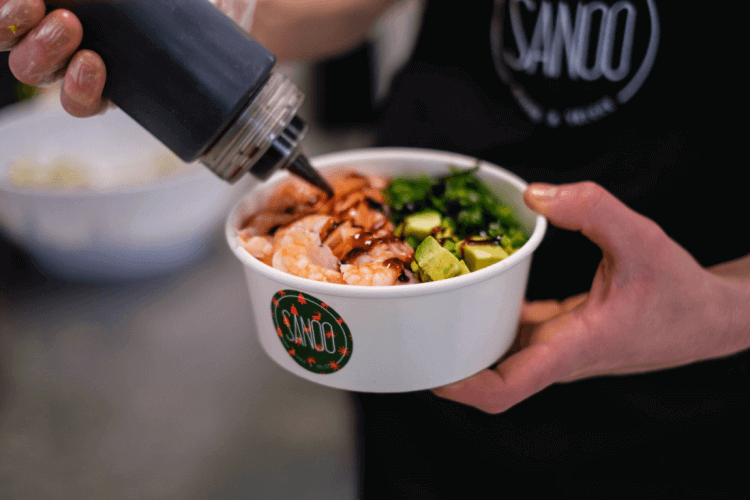Table of Contents Show
Get ready to shape the culinary game! Discover key strategies on how to start a Poke Bowl business, serving delicious, healthy meals to a global palate.
The poke bowl, a healthy snack from Hawaii, has taken the world by storm, blending vibrant flavors and fresh ingredients.
This culinary delight has not only captivated food enthusiasts but has also opened up a lucrative avenue for entrepreneurs looking to dive into the food industry. With its popularity on the rise, starting a poke bowl business could be your golden ticket to the entrepreneurial world.
Starting a poke bowl business can be an exciting and profitable venture. With the right planning and execution, you can shape the game and become a successful player in the industry.
What Are Poke Bowls?

Poke bowls are captivating palates globally, using a mix of components to produce a novel and healthy dining experience. Their infatuation primarily stems from a blend of fresh ingredients, ethnic fusion flavors, and customized offerings facilitating a new convenience in eating.
The global rise of poke bowls signifies a shift towards healthy, diverse, and sustainable dining trends, merging innovative culinary practices with convenience and customization.
The ‘Poke Bowl’ success story hinges on its nimble adaptability to the transforming landscape of the food industry. With a focus on health, diversity, and natural ingredients, it aligns perfectly with the expectations of contemporary consumers, setting new benchmarks in culinary innovation and dining trends.
The Rise of Poke Bowl in the Food Industry
Caught in the tide of transitioning food trends, warm comfort meal bowls were sideswiped by a cooler, lighter, and healthier alternative – the poke bowl. Seeing the rise of well-being consciousness, poke bowls swooped in, offering a nutritious punch in the belly of the food industry.
In the blink of an eye, poke bowls, a traditional Hawaiian dish, riding the wave of consumers’ increasing fondness for customizable meals. Their vibrant colors, diverse textures, and savory sauces lit up Instagram feeds – influencing foodies worldwide.
The poke bowl revolution didn’t just catch fire amongst health enthusiasts but permeated all strata of food lovers. With its eye-catching aesthetics and the rare combo of health and taste, it became a chart-topper, shaping the landscape of present-day food businesses.
Poke Food Market Overview

The poke food market, characterized by its traditional Hawaiian dish of diced raw fish, typically tuna, has been experiencing substantial growth and is expected to continue its upward trajectory.
As of 2023, the market was valued at approximately $7.8 billion, with forecasts suggesting it could reach $12.8 billion by 2032, growing at a CAGR of around 5.66% between 2024 and 2032. This growth is driven by factors such as the rising demand for healthy, convenient, grab-and-go food options, alongside the growing trend of online retail activities that have expanded the market reach.
However, the market faces challenges such as the depletion of tuna fish stock due to overfishing, which could hinder the industry’s expansion by raising product costs due to high demand and limited supply.
Additionally, import duties and supply chain disruptions pose significant challenges to market growth. Despite these obstacles, opportunities in online retail and the e-commerce sector are expected to fuel further growth, particularly as internet penetration and the popularity of online shopping continue to rise.
The market is primarily segmented by product type, with tuna being the predominant choice due to its traditional use and high nutritional content, making it a staple in poke dishes. The commercial sector, encompassing restaurants and food services that offer poke, holds a major share of the market, attributed to the increasing trend of dining out and the convenience of ready-to-eat options.
Geographically, North America has been a dominant force in the market, driven by a high demand for nutritious diets and a significant number of establishments offering poke foods. Europe is anticipated to exhibit significant growth, propelled by a rising demand for convenience foods and an increase in the working population. The Asia-Pacific region is also expected to see substantial growth due to the acceptance of cross-cultural food trends and a heightened interest in seafood for its health benefits.
Key industry players include Annasea Foods, Aloha Poke, Sweet Fin Poke, and Pokeworks, among others. These companies have been pivotal in the market’s development through strategic initiatives such as product innovations and expansions in the poke food offerings.
How To Start A Poke Bowl Business? In A Few Steps:
1. Researching the Market and Competition
Dive enthusiastically into market research to unravel vital trends and preferences in the poke bowl industry; a comprehensive understanding is crucial for your business to stand out.
Peer a little deeper behind the curtain, scrutinizing your competition and their unique offerings; a firm grasp of your rivals’ strategies enables you to carve a distinct niche for your poke bowl venture.
a. Analyzing Local Market Trends
- Spotlight on Trends: As an entrepreneur, it’s vital to grasp local market dynamics for your Poke Bowl business. Identify the existing trends and preferences among the locals, their frequency of dining out, and specific poke bowl preferences.
- Local Love for Poke: Tapping into local markets can provide your business with a built-in customer base. Collaborate with local food festivals and events to forge deeper connections with your community and keep a finger on the pulse of the evolving local food trends.
b. Identifying Competitors and Their Offerings
To carve out your niche in the poke bowl industry, an in-depth profile scan of key players is essential. This will provide a broader view of prevailing trends and the successful strategies employed by these industry stalwarts.
The circle of competition is another paramount perspective to consider. It involves a comprehensive understanding of your rivals’ offerings – from their unique selling points to the variety in their poke bowl menus.
A meticulous competitor analysis can shed light upon potential gaps in the market. They can be exploited to establish your poke bowl business as a standout option. Identifying what could make your brand different and enticing can set the ball of success rolling.
c. Differentiating Your Poke Bowl Business
In a market filled with similar offerings, defining what sets your Poke Bowl eatery apart is key. A unique identity could be the linchpin that drives traffic to your restaurant and creates loyal customers.
- Develop a unique twist in your poke bowl combinations. This can be in the form of a secret sauce or ingredients representative of local cuisine.
- Offer not just food but distinctive culinary experiences. These could be in the form of live cooking demonstrations, themed evenings, or cultural fusion menus.
- Create an impactful and compelling brand story that connects emotionally with your customers and differentiates them from competitors. This might include your journey, commitment to sustainability, or sourcing strategy.
- Design the restaurant layout and ambiance to mirror your brand’s values and aesthetic. Your décor should be an extension of your brand identity.
- Develop a recognizable and stylish logo and color scheme to set your business apart visually.
- Launch community initiatives under your brand name to foster a positive public perception and build strong local connections.
2. Crafting a Unique Poke Bowl Menu
A standout poke bowl menu can be conjured up by merging time-tested culinary principles with creative twists. It’s all about finding the right balance between tradition and innovation to create a tantalizing array of options that customers can’t resist.
Fine-tuning a unique menu is an art in itself. Consider incorporating diverse flavours accommodating dietary restrictions and sourcing ingredients consciously. When your menu exudes palatable perfection, it positions your poke bowl business in a league of its own.
a. Creating Delicious and Healthy Poke Bowl Combinations
Delving into the culinary art of creating poke bowl combinations can be an exciting journey. Pairings of fresh seafood with crunchy greens, avocado, and various sauces can result in a plethora of flavors bound to catch the foodie’s attention.
Devoting a special section of your menu to healthy combos can be an effective strategy. Incorporating kale, quinoa, or cauliflower rice, coupled with lean protein sources like tofu or chicken, will attract health-conscious customers.
Keeping the balance between taste and nutrition is key in crafting poke bowl pairings. Consider having dietitian-approved combos on your menu to assure customers about the health benefits of your offerings, while also satisfying their taste buds.
b. Catering to Dietary Restrictions and Preferences
In the increasingly diet-conscious world, catering your Poke menu to dietary restrictions is almost non-negotiable. By offering versatile options like vegan, gluten-free, and low-carb bowls, you gain the potential to attract a wider consumer base.
Reshaping your Poke Bowl Menu to suit diverse tastes is another significant ingredient to your venture’s success recipe. Analyzing your audience’s preference patterns and incorporating popular and appreciated ingredient combinations can subtly assure their dining satisfaction.
3. Sourcing High-Quality Ingredients
To ensure your poke bowl business stands out, you must navigate ingredient quandaries meticulously. Superior selection proves crucial – aim for sustainably sourced, high-quality seafood and fresh vegetables that burst with flavor.
Quality ingredients make the difference between an average and an exceptional poke bowl. Ingredients should not merely blanket the bowl, but create an unforgettable experience through their freshness, texture, and taste, driving your customers to return for more.
a. Establishing Relationships with Local Suppliers
Forging alliances with local suppliers serves as a foundation for your poke bowl business. Such relationships ensure you obtain high-quality, fresh ingredients while affirming your commitment to local economies.
Anchored in authenticity, your poke bowl business stands to gain immensely from deep-rooted supply chain relationships. Apart from encouraging sustainability, these ties bolster reliability and enrich your offering with ingredients that exude local charm and freshness.
b. Ensuring Freshness and Sustainability
Preserving ingredient freshness is vital for maintaining the authentic taste in your poke bowl ventures. Partner with suppliers who promote the same pristine, freshness standards and execute strict quality control to preserve the purity of your ingredients.
Catching the big green wave involves more than just meeting basic sustainability standards. Ensure your poke bowl business steps ahead by profiling your commitment to the environment, like sourcing from local fishermen who practice responsible fishing, reducing waste, and using eco-friendly packaging.
4. Creating an Efficient and Appealing Restaurant Setup

Designing your Poke Bowl outlet should marry efficiency and aesthetics. Plan the space layout meticulously, concentrating on smooth customer flow and an efficient kitchen, crucial to speedy and quality poke bowl production.
Building an inviting atmosphere is equally crucial. Use design elements that mirror the freshness and vitality a poke bowl offers. The use of natural, warm hues, clean lines, and quirky art will evoke a sense of connection and lure customers into your Poke Bowl business.
a. Designing an Inviting Interior
Creating an inviting interior means embracing the spirit of your Poke Bowl venture in your physical space. It’s not just about aesthetics, but also about embodying the freshness, health, and vibrancy of the dishes you are offering.
Design spaces that encourage relaxation and social interaction. Incorporate elements of Hawaiian culture, the birthplace of Poke bowls, to offer customers an experience that transcends just the culinary aspects.
Remember, a harmonious haven for your customers speaks volumes about your business. It signifies a commitment to customer comfort and can become a key factor in making your Poke Bowl business a beloved local spot.
b. Optimizing Workflow and Efficiency in the Kitchen
Your Poke Bowl kitchen needs to function like a well-oiled machine, ensuring swift preparation time for every order. Have clearly defined tasks for each team member and properly organize stations to streamline the workflow and decrease prep time.
During peak hours, excellent workflow management is key. By utilizing an efficient system that handles high-volume orders, you’ll keep up with customer demand, ensuring a smooth and quick service, thus enhancing customer satisfaction.
c. Choosing the Right Point-of-Sale System
When launching a Poke Bowl venture, opting for the right Point-of-Sale (POS) system can make all the difference. Not only will it reinforce your brand, but it can also provide efficiencies that streamline your operations, giving you the edge over competitors.
Having a robust, intuitive POS system will simplify the transaction process, lower error rates, and improve overall customer experience. So, be certain to select a system that reflects your business needs, is user-friendly, and aligns with your growth strategy.
Remember, the right POS system is more than just a tool for processing sales. It’s the backbone of your business operations – from managing inventory to tracking sales and even gauging customer satisfaction. Make it count!
5. Implementing Effective Marketing Strategies
Your Poke Bowl venture needs an effective marketing strategy to stand out. Consider dynamic tactics such as influencer collaborations, enticing loyalty programs, and innovative social media content to engage audiences and create buzz about your brand.
Brand building is another crucial facet in pushing your Poke Bowl startup forward. Cohesive and vibrant branding, from a thoughtfully designed logo to a well-implemented brand voice across all platforms, can position your venture as an exciting player in the culinary scene.
a. Leveraging Social Media and Online Platforms
On social media, your poke bowl shop, ‘By the Bowl,’ can find fertile ground. Enthusiastically share your succulent poke creations, unique restaurant atmosphere, and satisfied customer reviews. Your Instagram-worthy poke shots will lure in food lovers, creating a flavorful fan base.
Boost your Poke Bowl business even further by harnessing the power of online platforms. From Google My Business to Yelp, ensure your shop’s profile is fully optimized with complete information, appealing photos, and a request for customer reviews. Capitalizing on these digital channels promotes widespread visibility and entices potential patrons.
b. Engaging with the Local Community
To ignite local interest, initiate various community engagement strategies. Consider hosting events such as ‘poke bowl’ creation contests, tasting sessions, and pop-up food stands at local gatherings. It’s also beneficial to offer special promotions for local community members.
To foster stronger relationships, it’s essential to listen and engage. Regularly solicit feedback from community members, introduce a loyalty program, and ensure personal, attentive service. Encourage customers to share their favorite poke bowl combinations, facilitating interaction and creating a sense of ownership.
Involvement in local initiatives makes a huge difference. Sponsor local sports teams or contribute to community projects. It solidifies your role as an active community participant, further endearing your poke bowl business to locals and driving repeat visitation.
c. Partnering with Influencers and Bloggers
Leveraging the channel of influencers can significantly enhance your brand visibility. Form partnerships that resonate with your brand ethos and can stir curiosity about your poke bowl offerings among the influencer’s dedicated followers.
Meanwhile, cultivating relationships with food bloggers can effectively boost your poke bowl business. By enticing them to write about your unique poke bowl combinations, you not only garner reviews but also further amplify your brand reach in a very organic manner.
Challenges In Poke Bowl Business Setup
Setting up a poke bowl business comes with its own set of challenges that entrepreneurs need to navigate carefully to ensure success. These challenges span various aspects of the business, from supply chain management to adapting to market trends.
1. Supply Chain Management
One of the main challenges in running a poke bowl business is managing the supply chain effectively. Ensuring a consistent supply of fresh, high-quality ingredients like tuna and other seafood is crucial since the freshness of ingredients directly impacts the quality of the final product.
However, fluctuations in seafood availability and prices can pose significant challenges. Factors such as overfishing have led to a depletion of tuna stocks, which can limit supply and increase costs. Additionally, supply chain disruptions and increased import duties can further complicate procurement processes.
2. High Operational Costs
Operational costs, including rent, utilities, and labor, can be high, especially in prime locations where foot traffic is substantial. These overheads can eat into profit margins, making it challenging to maintain a balance between quality, pricing, and profitability.
3. Market Saturation
In some regions, the market for poke bowls can be highly saturated, with numerous competitors ranging from small independent outlets to large chain restaurants. Differentiating your offering in a crowded market requires innovative approaches to menu design, marketing, and customer experience.
4. Adherence to Health Regulations
Given that poke bowls often include raw fish, adherence to health and safety regulations is paramount. This requires rigorous standards in food handling, preparation, and storage, which can necessitate additional training for staff and investment in high-quality kitchen facilities.
5. Keeping Up with Trends
The food industry is trend-driven, and the popularity of certain cuisines can fluctuate. Staying relevant means keeping up with food trends, customer preferences, and dietary requirements, such as the increasing demand for organic and sustainably sourced ingredients.
6. Pricing Strategies
With the primary ingredient being seafood, particularly tuna, the poke bowl business faces the challenge of pricing. Tuna prices can be volatile, impacted by factors like reduced catches and demand-supply imbalances, especially in the wake of global events like the COVID-19 pandemic. Such volatility can make it difficult to maintain consistent pricing and profit margins.
7. Customer Education
In regions where poke bowls are a relatively new concept, there might be a need for customer education regarding the dish’s origins, ingredients, and health benefits. This can require additional marketing efforts and resources to build a customer base.
8. Navigating Cultural Sensitivities
As poke is a traditional Hawaiian dish, businesses must be mindful of cultural sensitivities and the appropriation of cultural foods. This includes respecting the origins of the dish, using authentic recipes, and potentially educating customers about its cultural significance.
Overcoming these challenges requires a well-thought-out business plan, a robust understanding of the market, and a flexible approach to business operations. Entrepreneurs need to be prepared to adapt to changing market conditions, manage costs effectively, and maintain high standards of food quality and safety to succeed in the competitive poke bowl business landscape.
FAQ’s
1. What permits and licenses do I need to start a poke bowl restaurant?
You’ll need a range of permits and licenses, that may include a food service permit, business license, health department permit, and possibly a liquor license if you plan to serve alcohol. The specific requirements can vary by location, so it’s important to check with your local government
2. How much does it cost to start a poke bowl restaurant?
The initial investment for a poke bowl restaurant can vary widely based on location, size, and level of customization. Expenses include lease, renovations, equipment, initial inventory, permits, and marketing. It’s essential to create a detailed financial plan to estimate these costs accurately.
3. How do I ensure my poke bowl restaurant is successful in the long term?
Continuous adaptation to market trends, customer feedback, and operational efficiency is vital. Regularly updating your menu, maintaining high standards of customer service, and innovative marketing can help sustain growth and ensure long-term success.
Conclusion
By following the steps outlined in this guide, you can confidently start your own poke bowl business and make a positive impact in the industry. With determination and a passion for creating delicious and healthy food, you have the potential to shape the game and achieve success.
Let us know if this blog is helpful, and share your feedback via email at: hi@productivityshift.com
More related articles:










